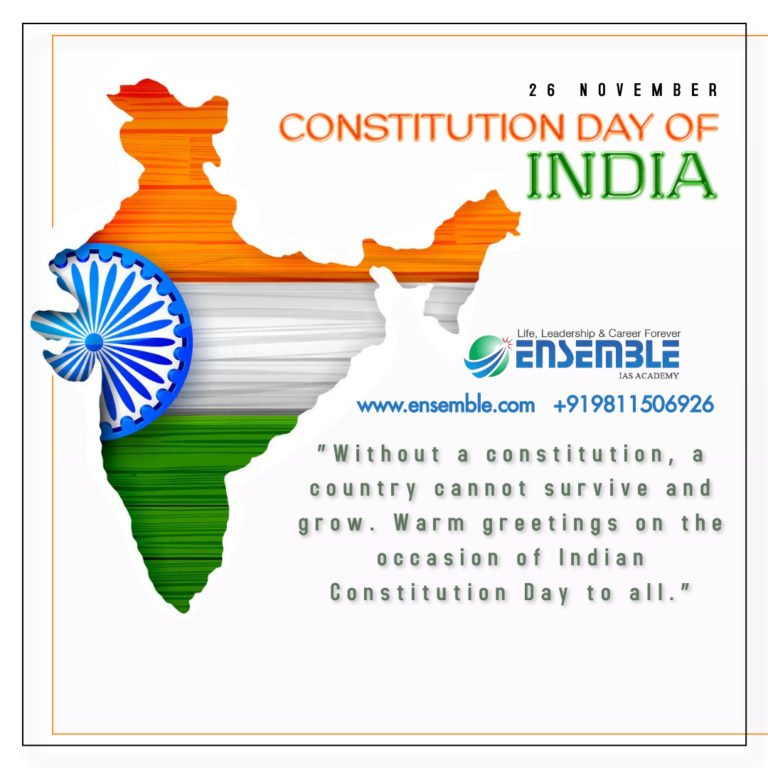
Overview: India observes Constitution Day annually on November 26, to commemorate the adoption of the Constitution of India. This day is also known as Samvidhan Divas. It is a day to reflect on the importance of the Constitution and honor those who contributed to its creation.
History of the Constitution of India
For any country Constitution is that written text in which the vision and theme of that particular democracy is documented and as a guide it is followed by the leaders of the country. It is a comprehensive legal document that serves as the country’s supreme law and the basis for India’s government. It outlines the rights, responsibilities, and freedoms of Indian citizens, as well as the government’s structure and operations.
It is a known fact that after being under the British rule for 200 years, India achieved independence in 1947. A Constituent Assembly was constituted which constituted the basic framework of our constitution. The senior leaders were allotted different roles whom we know them as the Founding Fathers of our Constitution.
The link to join the course : Online Courses
Founding Fathers of our Constitution
- Dr B.R. Ambedkar
- Referred to as the ‘Father of the Constitution’, Dr Ambedkar played a leading role in the Constitution’s framing process.
- He was the Chairman of the Assembly’s most crucial committee – the Drafting Committee.
- He was directly responsible for preparing the draft Constitution for Independent India.
- Appointed as the first Law Minister of independent India in 1947.
- Dr. Rajendra Prasad
- President of the Constituent Assembly.
- Elected as the first President of independent India on 24th Jan 1950, at the last session of the Constituent Assembly.
- Distinction of being the only President to have been re-elected for a second term (1950-1962).
- Sardar Vallabh Bhai Patel
- Sardar Vallabhbhai Patel was a key member of the Constituent Assembly.
- He was instrumental in the integration of over 500 princely states into the Indian Union.
On 26th November 1949, the Constituent Assembly of India adopted the Constitution of India, which came into effect from 26th January 1950.
The Ministry of Social Justice and Empowerment on 19th November 2015 notified the decision of Government of India to celebrate the 26th day of November every year as ‘Constitution Day’ to promote Constitution values among citizens.
Constitution Day Observance
Various events, symposiums, and educational activities take place nationwide on this day to commemorate the Constitution’s importance and reaffirm commitment to its principles of justice, equality, liberty, and fraternity.
Sections of the Indian Constitution
The whole edifice of the Constitution and structure of the political system protect and promote constitutional values embodied in the Preamble:
WE, THE PEOPLE OF INDIA, having solemnly resolved to constitute India into a SOVEREIGN SOCIALIST SECULAR DEMOCRATIC REPUBLIC and to secure to all its citizens:
JUSTICE, social, economic and political;
LIBERTY of thought, expression, belief, faith and worship;
EQUALITY of status and of opportunity;
and to promote among them all
FRATERNITY assuring the dignity of the individual and the unity and integrity of the Nation.
IN OUR CONSTITUENT ASSEMBLY this 26th day of November, 1949, do HEREBY ADOPT, ENACT AND GIVE TO OURSELVES THIS CONSTITUTION
The Indian Constitution consists of 448 articles, each outlining specific aspects of governance, rights, responsibilities, and the country’s structure.
Features of our Indian Constitution
1. The Indian Constitution holds the distinction of being one of the lengthiest written constitutions worldwide.
2. Preamble: It outlines the guiding values, including justice, liberty, equality, and fraternity.
3. Federal Structure: The Constitution establishes a federal system, highlighting a powerful central government while outlining the distinct powers of state governments.
4. Fundamental Rights: It assures fundamental rights to all citizens, including the right to equality, freedom of speech, and the right to life and personal liberty.
5. Directive Principles of State Policy: These principles set socio-economic targets for the government, promoting social justice, welfare, and balanced development.
6. Parliamentary Democracy: The Constitution adopts a parliamentary system, appointing the President as the head of state and the Prime Minister as the head of government.
7. Independent Judiciary: It creates an autonomous judiciary, with the Supreme Court at the top of the hierarchy, responsible for interpreting and upholding the Constitution.
8. Separation of Powers: It partitions powers between the executive, legislature, and judiciary to prevent authority from being centralized.
9. Universal Adult Franchise: The Constitution ensures universal adult suffrage, guaranteeing voting rights for all citizens.
10. Amendment Procedure: The Constitution permits its amendment to accommodate shifting circumstances, mandating specific majority thresholds for various types of amendments.
Best Online Coaching for Civil Service_IAS_ UPSC_IFS_IPS
Free Study Material ENSEMBLE IAS ACADEMY | Call +91 98115 06926
Visit us:- https://ensembleias.com/ | Online Store: https://online.ensemble.net.in/



